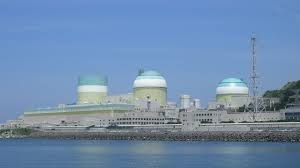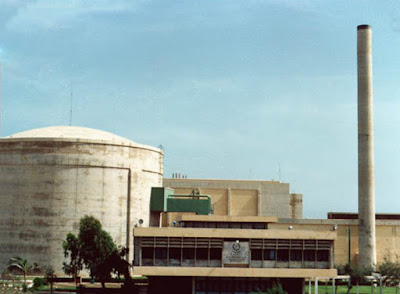Major
sources of electricity generation are Thermal (both gas and oil), Hydro power,
Nuclear power, Renewable energy. There are four major power producers in country
which include Water & Power Development Authority (WAPDA), Karachi Electric
Supply Company (KESC), Independent Power Producers (IPPs) and Pakistan Atomic
Energy Commission (PAEC).Since independence from United Kingdom in 1947, Pakistan
had repeatedly suffered energy crises that contributed to country's economic slowdown.
Pakistan
is the first Muslim country in the world to construct
and operate civil nuclear power plants. Pakistan is one of the four nuclear
armed states (along with India, Israel, and North Korea) that is not a party to
the Nuclear Non-Proliferation Treaty but is a member in good standing of the
International Atomic Energy Agency. Pakistan plans on constructing 32 nuclear
power plants by 2050. Total existing installed power capacity as of June 30,
2012 was 22,797 MW in the form of thermal (69% of Pakistan’s Capacity) , hydro
(29%) and nuclear power plants (3%). The available power at any given time is
substantially below the installed capacity and reaches its nadir during the
winter when low water levels reduce the hydro power output.
Chashma
Nuclear Power Complex
The Chashma
Nuclear Power Complex near Chashma city is a commercial nuclear power
generation complex. Chashma Nuclear Power Complex consists of four power plants.
·
Chashma
Nuclear Power Plant-I (CHASNUPP-I)
·
Chashma
Nuclear Power Plant-II (CHASNUPP-II)
·
Chashma
Nuclear Power Plant-III ( CHASNUPP-III)
·
Chashma
Nuclear Power Plant- IV( CHASNUPP-IV)
Chashma
Nuclear Power Plant's reactors are being built and operated by the Pakistan
Atomic Energy Commission with Chinese support .These Nuclear Power Plant's
reactors and other facilities are approved by International Atomic Energy Agency.
Karachi
Nuclear Power Complex
The
Karachi Nuclear Power Plant (KANUPP) has a heavy water moderated and cooled
natural uranium fuelled, horizontal pressure tube reactor. Karachi Nuclear
Power Complex (KNPC) is located in Paradise Point Karachi Pakistan. It consists
of
·
Karachi
Nuclear Power Plant1 (KANUPP1)
·
Karachi
Nuclear Power Plant2 (KANUPP2)
·
Karachi
Nuclear Power Plant3 (KANUPP-3)
·
Karachi
Nuclear Power Plant4 (KANUPP-4)
The KANUPP-I is a CANDU reactor with a
total gross capacity of 137 MW. The KANUPP-I is supplied by the Canadian
Government in 1972. KANUPP-2 will cost $4.8 billion and produce around 1,100 MW.
According to Dr. Ansar Pervaiz, the Chairman of the Pakistan Atomic Energy Commission
KANUPP-2 would begin commercial operations by 2019insh Allah. KANUPP-3 will produce
around 1,100 MW. KANUPP-4 is a planned commercial nuclear power plant, to be
located at Karachi.
Khushab Nuclear Complex
Khushab Nuclear Complex is a plutonium
production nuclear reactor and heavy water complex situated in Jauharabad District
Khushab, Punjab, Pakistan. The heavy water and natural uranium reactors at
Khushab are a central element of Pakistan's program to produce plutonium and
tritium for use in compact nuclear warheads. Khushab Nuclear Complexes are not
subject to International Atomic Energy Agency inspections. Plutonium production
and nuclear reprocessing facilities are being expanded at this site. Khushab
Nuclear Complex is capable of producing 33 kg of weapons grade plutonium annually.
Khushab Nuclear Complex consists of
total five reactors identical to each other.
·
1
Khushab-I
·
2
Khushab-II
·
3
Khushab-III
·
4
Khushab-IV
·
5
Khushab-V
Khushab-I began production in early 1998.It
is a 50 MWt Heavy water and natural uranium research reactor for production of
plutonium and tritium for advanced compact warheads. The construction of
Khushab II went in production in 2010.Khushab-II is a 50 MWt Heavy water
reactor producing 11-15 kilogram of plutonium and tritium a year for the
Pakistan's nuclear weapons programme.Khushab III went in production in October
2013. Khushab-III is a 50 MWt Heavy water reactor producing 11-15 kilogram of
plutonium and tritium a year for the Pakistan's nuclear weapons programme.
Khushab-IV nuclear reactor site at a facility that generates plutonium for
nuclear bombs. Khushab-V is near to complete and will start production soon
insha Allah.
I
would like to share with you an article produced by SciDev.Net's South Asia desk.
Pakistan’s
nuclear energy plans: Q&A with physicist Abdul H Nayyar
Interview with senior physicist Abdul Hameed
Nayyar
China is transferring nuclear technology to
Pakistan, a country that has not signed the Treaty on the Non-Proliferation of
Nuclear Weapons (NPT). China has been able to defy NSG restrictions because NSG
had already weakened its own position by giving a waiver to India. China has
taken a position that it made these supply agreements with Pakistan before
becoming a member of NSG in 2004, and is therefore following a
'grandfather' agreement. This certainly is true for the Chashma reactors. But
is it also true for the Karachi reactors?
Nayyar: The doubters point out that the
kind of reactors China is supplying to Karachi were not even designed in 2004.
In my opinion, this nit picking is fruitless. The China-Pakistan nuclear deal
will not be challenged at international legal forums.
But isn't the Obama
administration also trying to revive the 2008 deal with India so that American
companies may invest in nuclear power plants in India? India has not signed the
NPT either.
Nayyar: Yes, the US is desperately
looking for ways to find a nuclear market in India. India has money and a need
for large nuclear power reactors, and the American nuclear industry is short of
buyers. Bush had promised that the US-India nuclear deal would revive the US
nuclear industry and create jobs; that did not happen because of the Indian
liability law, which lays that the liability in case of accidents will be on
both operators and manufacturers.Obama has now tried to push India to somehow
circumvent the liability law. That has not happened yet. The big question is,
will it?
The world over, generating power
through nuclear reactors (31 countries are generating power through nuclear
reactors) is seen as a viable option, why not here in Pakistan?
Nayyar: No, the global trend is not in favor
of nuclear power. Many countries have abandoned nuclear power. Germany is a
prime example. There are other examples too. No nuclear reactor has come into
operation in the US for over 43 years. A few are under construction now but
they have not set any trend. China is certainly a strong counter-example. It
has set up several nuclear industrial corporations, which have invested so
heavily in the acquisition of the technical skill that they are now keen to
export nuclear power technology abroad. The Pakistan-China nuclear trade can be
explained by a simple fact that no other country in the world is ready to sell
a nuclear power reactor to Pakistan, and no other country has shown any
interest in buying nuclear power reactors made in China so far. It is a
marriage of convenience.
What is your biggest concern if
the reactors are built?
Nayyar: Our biggest concerns are two: a
Fukushima or Chernobyl-like accident at the new reactors, and inexperience with
the reactor design. The reactors are situated too close to the metropolis of
Karachi. The Fukushima accident effects were observed up to a distance of 30 kilometers
from the reactor site. From the proposed Karachi reactor site, the area up to
30 kilometers includes a densely populated area. If a severe accident happens at
these reactors, these areas would be closed down for years. The impact of such
a closure on the economy of Pakistan is going to be tremendous. Also please
recall that the entire population within the areas up to 30 kilometers of
Fukushima was evacuated and has not been allowed in even after four years since
the accident. Imagine evacuating the entire population of Karachi. Is it really
possible? If we fail to evacuate 18 million people imagine the number of people
that would get radiation sickness.
So
how do you see Pakistan overcoming its energy crisis?
Nayyar: This is a good question. Let us
explore what is possible other than nuclear. We should note that in China, from
where we are buying nuclear reactors for Karachi, is developing very strong
wind energy and solar energy technologies, both of which are larger in
magnitude in installed capacity than nuclear power. As against the total
nuclear electricity generating capacity of about 17 gigawatts (1 gigawatts =
1,000 megawatts), China has installed wind power plants of total capacity of 76
gigawatts. In the year 2014 alone, China installed wind power plants of 20
gigawatts capacity. If China can install such a large number of windmills on
its soil, it must have a very strong windmill-manufacturing base. This means
that Pakistan could ask China to extend to it the same loan that it is giving
for Karachi nuclear plants (US$6.4 billion) to set up wind power manufacturing plants.
Pakistan is said to have a wind power capacity of at least 40,000 megawatts.
Chinese loan could be used to establish a windmill manufacturing industry. The
wind power has the characteristic that its installation cost is nearly half as
much as nuclear plant, and has zero fuel cost. Wind electricity comes out much
cheaper than nuclear electricity.
The global growth in wind power
is phenomenal. Nearly 50,000 megawatts of new plants are installed every year
globally. Pakistan needs only another 10,000 megawatts to meet all its power needs.
Then there is solar photovoltaic technology, the cost of which has tumbled down
enormously recently. And like wind power it is also modular in nature. The
Punjab government has wisely embarked on a project to install solar power in
modules of five megawatts and aims at 1,000 megawatts. Hence the answer to your
question lies in wind and solar power plants.














0 Reviews:
Post Your Review